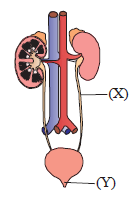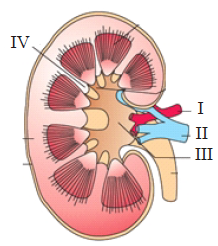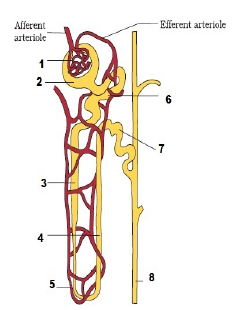Please see Chapter 19 Excretory Products and Their Elimination Exam Questions Class 11 Biology below. These important questions with solutions have been prepared based on the latest examination guidelines and syllabus issued by CBSE, NCERT, and KVS. We have provided Class 11 Biology Exam Questions and answers for all chapters in your NCERT Book for Class 11 Biology. These solved problems for The Living World in Class 11 Biology will help you to score more marks in upcoming examinations.
Exam Questions Chapter 19 Excretory Products and Their Elimination Class 11 Biology
Objective Questions
Question. The ascending loop of Henle is permeable for
(a) ammonia
(b) glucose
(c) sodium
(d) water
Answer
C
Question. In comparison to blood plasma, percentage of glucose in glomerular filtrate is
(a) higher
(b) equal
(c) lower
(d) nil
Answer
B
Question. The maximum reabsorption of useful substances back into the blood from filtrate in a nephron occurs in
(a) PCT
(b) Loop of Henle
(c) DCT
(d) collecting duct
Answer
A
Question. The part of the nephron that helps in active reabsorption of sodium is
(a) bowman’s capsule
(b) distal convoluted tubules
(c) ascending limb of Henle’s loop
(d) proximal convoluted tubules
Answer
C
Question. Which of the following hormone is secreted from kidney ?
(a) ANF
(b) Erythropoietin
(c) Rennin
(d) Aldosterone
Answer
B
Question. In the renal tubules the permeability of the distal convoluted tubule and collecting duct to water is controlled by
(a) aldosterone
(b) vasopressin
(c) growth hormone
(d) renin
Answer
B
Question. Volume of urine is regulated by
(a) aldosterone
(b) aldosterone and ADH
(c) aldosterone, ADH and testosterone
(d) ADH alone
Answer
B
Question. Juxta-glomerular cells of renal cortex synthesizes an enzyme called
(a) ADH
(b) oxytocin
(c) renin
(d) urochrome
Answer
C
Question. The voluntary response to the distension of urinary bladder is
(a) polyurea
(b) micturition
(c) mellitus
(d) menstruation
Answer
B
Statement Type Questions
Question. Which of the following statement is not correct with respect to human kidney?
(a) The peripheral region is called cortex and central medulla.
(b) Malpighian capsules are present in the cortex region.
(c) Blood enters glomerulus through efferent arterioles.
(d) The concave part of kidney is called hilus.
Answer
C
Question. Almost all the aquatic animals excrete ammonia as the nitrogenous waste product. Which of the following statement is not in agreement with this situation?
(a) Ammonia is easily soluble in water.
(b) Ammonia is released from the body in a gaseous state.
(c) Ammonia is highly toxic and needs to be eliminated as and when formed.
(d) Ammonia gets converted into a less toxic form called urea.
Answer
D
Question. Which one of the following statements is correct with respect to kidney’s function and regulation?
(a) During summer when body loses lots of water by evaporation, the release of ADH is suppressed.
(b) When someone drinks lot of water, ADH release is
(c) Exposure to cold temperature stimulates ADH release.
(d) An increase in glomerular blood flow stimulates formation of Angiotensin II.
Answer
B
Question. Which of the following statement is incorrect?
(a) Counter-current flow of blood in vasa recta helps to retain the reabsorbed sodium in the renal medulla.
(b) Glomerular filterate is protein free plasma.
(c) Vasa recta carry glomerular filterate from distal convoluted tubule to the collecting duct.
(d) Glomerular filterate in Bowman’s capsule is isotonic to the plasma.
Answer
C
Question. Which of the following statements is/are true?
(i) Urine is hypertonic in distal convoluted tubule.
(ii) When the urine passes into the collecting tubule, it becomes hypotonic.
(iii) Urine is isotonic in proximal convoluted tubule.
(iv) Urine becomes more and more hypotonic as it passes through the Henle’s loop.
(a) (i) and (iv) only
(b) (i), (ii) and (iii) only
(c) (ii) and (iii) only
(d) (iii) only
Answer
D
Assertion/Reason Type Questions
In the following questions, a statement of Assertion is followed by a statement of Reason.
(a) If both Assertion and Reason are true and the Reason is the correct explanation of the Assertion.
(b) If both Assertion and Reason are true but the Reason is not the correct explanation of the Assertion.
(c) If Assertion is true but Reason is false.
(d) If both Assertion and Reason are false.
Question. Assertion : Kidney maintains the osmotic concentration of the blood.
Reason : Kidney eliminates either hypotonic or hypertonic urine according to the need of the body.
Answer
A
Question. Assertion : Secreting hypotonic urine is effective in reducing urinary loss of water.
Reason : Hypotonic urine is more concentrated and higher in osmotic pressure than the blood.
Answer
D
Question. Assertion : Main constituent of human urine is ammonia.
Reason : If human urine is allowed to stand for some time, it smells strongly of ammonia.
Answer
D
Diagram Type Questions
Question. The label X and Y in the given diagram of human urinary system represents

(a) X- Urethra, Y- Ureter
(b) X- Ureter, Y- Urethra
(c) X- Bladder, Y- Urethra
(d) X- Ureter, Y- Bladder
Answer
B
Question. The given figure shows the longitudinal section of kidney with few structures labelled as I, II, III & IV identify renal vein in the given figure.

(a) I
(b) II
(c) III
(d) IV
Answer
B
Directions : Refer the given diagrammatic representation of a nephron of human excretory system and answer the following questions.

Question. Which blood component would not usually pass through the membranes from region A to region B?
(a) Mineral salts
(b) Red blood cells
(c) Urea
(d) Water
Answer
B
Directions : Refer the given figure of nephron showing blood vessels and duct and answer the questions.

Question. Which parts in the above figure have minimum reabsorption and play a significant role in the maintenance of high osmolarity of medullary interstitial fluid?
(a) 1 and 2
(b) 3 and 4
(c) 5 and 6
(d) 7 and 8
Answer
B
Question. Which part is capable of reabsorption of HCO3 – and selective secretion of hydrogen and potassium ions and NH3 to maintain the pH and sodium-potassium balance in blood?
(a) 1
(b) 3
(c) 5
(d) 7
Answer
D
Critical Thinking Type Questions
Question. There is no sugar in urine. The blood entering the kidney has more sugar than leaving the kidney because
(a) sugar is used by kidney cells in metabolism.
(b) sugar is absorbed by bladder.
(c) sugar is absorbed by proximal convoluted tubule.
(d) sugar is absorbed in Loop of Henle.
Answer
A
Question. If the diameter of afferent renal arteriole is decreased and that of efferent renal arteriole increased, ultra filtration will
(a) be faster
(b) be slower
(c) not take place
(d) take place in the same speed
Answer
C
Question. In a kidney machine, which of the following passes from the blood to the dialysis fluid?
(a) Glucose
(b) Plasma protein
(c) Red blood cells
(d) Urea
Answer
D
Question. Urine of a human suffering from diabetes inspidus is
(a) concentrated with glucose
(b) concentrated without glucose
(c) watery with glucose
(d) watery without glucose
Answer
D
Question. Which one of the following enables the mammalian kidney to regulate water reabsorption during states of dehydration?
(a) The cells of the tubules detect the osmotic pressure of the blood.
(b) Water is extracted from the glomerular filtrate in the proximal tubules.
(c) The kidney produces a hypotonic urine.
(d) Hormones increase the permeability of the collecting ducts.
Answer
D
Question. “X” causes reabsorption of “Y” and water from the distal parts of the tubule. This also leads to an increase in “Z” and glomerular filtration rate (GFR).
Identify X, Y and Z.
(a) X: ADH; Y: Na+; Z: Blood pressure
(b) X: ADH; Y: K+; Z: Blood pressure
(c) X: Aldosterone; Y: Na+; Z: Blood pressure
(d) X: Aldosterone; Y: K+; Z: Ionic concentration
Answer
C
Question. Identify the parts mentioned below which constitute a part of single uriniferous tubule.
i. Loop of Henle.
ii. Collecting duct
iii. Bowman’s capsule
iv. Distal convoluted tubule
(a) i, ii and iii
(b) ii, iii and iv
(c) i, iii and iv
(d) All of the above
Answer
C
Question. Which are the following group of hormones participate in the regulation of the renal function?
(a) ADH, TSH and ANF
(b) PCT, TSH and ANF
(c) ADH, DCT and Aldosterone
(d) ADH, ANF and Aldosterone
Answer
D